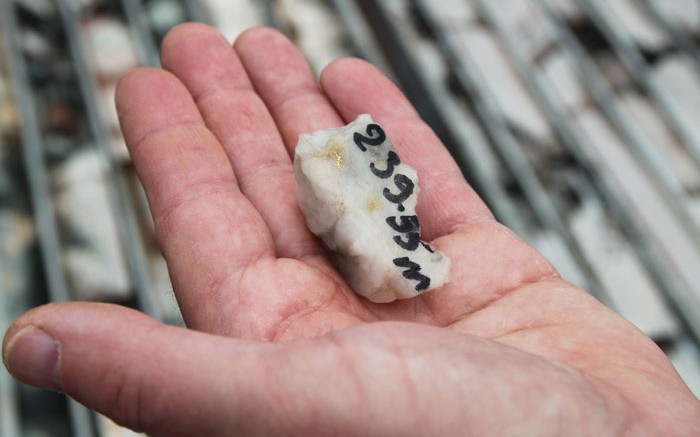Roxgold (TSXV: ROG) is trying to define a second resource on its 100%-owned Yaramoko property in Burkina Faso’s Houndé greenstone region, and the latest drill results from the company’s QV1 target — about 1.8 km south of its flagship 55 Zone where development is expected to start in the fourth quarter of this year — appear encouraging.
Infill drilling at the QV1 target in the Bagassi South Zone has returned a number of high-grade intercepts, such as 226.76 grams gold per tonne over 3.1 metres (2.7 metres true width), including 442.00 grams gold over 1.6 metres (1.4 metres true width). Other highlights are 3.04 grams gold over 5.0 metres (3.2 metres true width), including 11.30 grams gold over 0.6 metre (0.3 metre true width).
Two hundred metres to the west along strike from QV1 another intercept returned 2.44 grams gold over 1.7 metres (1.5 metres true width), including 6.56 grams gold over 0.6 metre (0.5 metre true width).
The QV1 target remains open at depth and along strike. So far, Roxgold has drill tested to around 200 metres vertically and is currently testing the QV1 target down to a depth of around 300 metres, as well as looking to expand the current footprint along strike.
“QV1 is starting to hold together well with about 10 strong intercepts into it already and more holes currently being drilled,” Ben Pullinger, Roxgold’s vice president of exploration, told The Northern Miner in an email from Burkina Faso. “The QV1 target is similar in setting to the 55 Zone with the majority of the mineralization encountered to date being hosted within granitic bodies within brittle structures. The orientation and kinematics of QV1 and Bagassi South, though, are slightly different, although in both cases dilational zones were formed allowing for the precipitation of high- grade gold mineralization.”
Currently Roxgold has three rigs turning on the permit, Pullinger says. The first rig is defining QV1. The second, which has tested targets around Bagassi South, is now testing IP and geochemical anomalies along the central Bagassi Trend between the 55 Zone and Bagassi South. The third, a reverse circulation rig, is testing IP, geochemical and structural targets at the Haho target and along the Boni Shear, where exploration work earlier this year defined an eight-kilometre-long trend of anomalous geochemistry results.
The company has $5 million budgeted for regional exploration this year, of which $2 million has been assigned to the Bagassi South area.
John Dorward, Roxgold’s president and chief executive, explained in an email that he is very encouraged by the results at the QV1 target, which he describes as the company’s “highest potential regional exploration target” to date, and says that ideally Roxgold would like to delineate a resource at Bagassi South by the end of 2014.
“While it’s still early days, we feel that QV1 offers the potential to become a second resource at Yaramoko, and we will continue to explore there as well as at other targets on the permit to further define that over the next months.”
In a research note to clients, BMO Capital Markets said that Bagassi South is beginning to look like an opportunity for growth.
“While still early stage, the current program appears to build on previous drill results and may ultimately define a potential satellite deposit in close proximity to the 55 Zone,” analyst Andrew Breichmanas said.
“BMO Research expects that if a resource approaching 200,000 oz. can be defined, Bagassi South could be evaluated for potential to supplement 55 Zone ore and add 10,000-20,000 oz. per annum to Yaramoko production.”
In addition to its diamond drill program at QV1, Roxold has kicked off a reverse circulation drill program at a second target at Bagassi South called Haho.
The larger Yaramoko claims contain many worthy targets, including Bagassi South, 117 Zone, Haho, and the ground along the Boni Shear Zone, according to analysts Tara Hassan and Ardem Keshishian of Haywood Securities.
“Although these targets remain in the early stages, continued positive results, like those issued today from Bagassi South, suggest that there is potential to meaningfully extend the mine life at the project or boost annual production from the satellite targets,” they write in a note to clients.
News of the drill results sent Roxgold’s shares up 5.9%, or 4¢, to close at 72¢, with 1.4 million shares changing hands. Over the last year the company has traded in a range of 36¢-76¢.


Be the first to comment on "Drill results drive Roxgold’s shares higher"